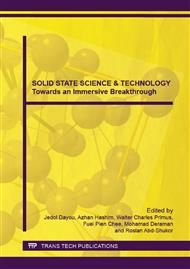[1]
D. Saikia, A. Kumar, Ionic transport in P(VDF-HFP)−PMMA−LiCF3SO3−(PC+DEC)−SiO2 composite gel polymer electrolyte, European Polymer Journal, 41 (2005) 563-568.
DOI: 10.1016/j.eurpolymj.2004.10.029
Google Scholar
[2]
R. Kumar, J. P. Sharma, S. S. Sekhon, FTIR study of ion dissociation in PMMA based gel electrolytes containing ammonium triflate: Role of dielectric constant of solvent, European Polymer Journal, 41 (2005) 2718-2725.
DOI: 10.1016/j.eurpolymj.2005.05.010
Google Scholar
[3]
S. Rajendran, V.S. Bama, M.R. Prabhu, Effect of lithium salt concentration in PVAc/PMMA-based gel polymer electrolytes, Ionics, 16 (2010) 27-32.
DOI: 10.1007/s11581-009-0329-1
Google Scholar
[4]
R. Idris, M. D. Glasse, R. J. Latham, R.G. Linford, W. S. Schlindwein, Polymer electrolytes based on modified natural rubber for use in rechargeable lithium batteries, Journal of Power Sources, 94 (2001) 206-211.
DOI: 10.1016/s0378-7753(00)00588-7
Google Scholar
[5]
F. Latif, M. Aziz, N. Kartun, A. M. M. Ali, M. Z. Yahya, The role and impact of rubber in poly(metyl metacrylate)/lithium triflate electrolyte , Journal of Power Sources, 159 (2006) 1401-1404.
DOI: 10.1016/j.jpowsour.2005.12.007
Google Scholar
[6]
R. Idris, N. H. N. Mohd, N. M. Arjan, Preparation and characterization of the polymer electrolyte system ENR 50/PVC/PC/EC/LiN(CF3SO2)2 for electrochemical device application, Ionics, 13 (2007) 227-230.
DOI: 10.1007/s11581-007-0096-9
Google Scholar
[7]
X. Hou, S. S. Kok, Mechanical properties and ionic conductivities of plasticized polymer electrolytes based on ABS/PMMA blends , Polymer, 41 (2000) 8689-8696.
DOI: 10.1016/s0032-3861(00)00270-6
Google Scholar
[8]
S. Zhou, S. Fang, High ionic conductivity of all-solid polymer electrolytes based on polyorganophosphazenes , European Polymer Journal, 43 (2007) 3695-3700.
DOI: 10.1016/j.eurpolymj.2007.06.001
Google Scholar
[9]
G. B. Appetecchi, F. Croce, B. Scrosati, Kinetics and stability of the Lithium Electrode in Poly (methyl metacrylate)- Based Gel Electrolytes , Electrochimia Acta, 40(8) (1995) , 991-997.
DOI: 10.1016/0013-4686(94)00345-2
Google Scholar
[10]
D. A. Kumar, S. Selvasekarapandian, R. Baskaran, T. Savitha, H. Nithya, Thermal, vibrational and Ac impedance studies on proton conducting polymer electrolytes based on poly(vinyl acetate), Journal of Non-Crystalline Solids, 358 (2012) 531-536.
DOI: 10.1016/j.jnoncrysol.2011.11.031
Google Scholar
[11]
R. Kumar, J. P. Sharma, S.S. Sekhon, FTIR study of ion dissociation in PMMA based gel electrolytes containing ammonium triflate: Role of dielectric constant of solvent, European Polymer Journal, 41 (2005) 2718-2725.
DOI: 10.1016/j.eurpolymj.2005.05.010
Google Scholar
[12]
R. Kumar, S. S. Sekhon, Conductivity, FTIR studies, and thermal behavior of PMMA-based proton conducting polymer gel electrolytes containing triflic acid, Ionics, 19 (2013) 1627-1635.
DOI: 10.1007/s11581-013-0890-5
Google Scholar
[13]
M. Grayson, Internet Electronic Journal of Molecular Design, (2003).
Google Scholar
[14]
O. Hiroyuki, Y. F. Masahiro, M. Tomonobu, Ionic conductivity, in: O. Hiroyuki (2nd edition), Electrochemical Aspects of Ionic Liquid, Wiley, 2011, pp.87-89.
Google Scholar


